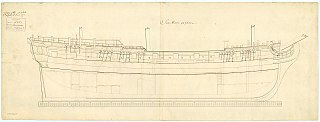Citations
- ↑ "The Marine List". Lloyd's List. No. 5803. 16 May 1823. hdl:2027/mdp.39015004293968.
Several vessels have been named Belisarius (or Bellisarius), for Belisarius:

HMS Seahorse was a 24-gun sixth-rate frigate of the Royal Navy, launched in 1748. She is perhaps most famous as the ship on which a young Horatio Nelson served as a midshipman. She also participated in four battles off the coast of India between 1781 and 1783. The Royal Navy sold her in 1784 and she then became the mercantile Ravensworth. She made one voyage for the British East India Company (EIC) between 1786 and 1788. In 1789, she was sold to the French East India Company which had her refitted and renamed her Citoyen. In 1793 the French Navy purchased her and used her as a frigate. She was last listed in 1801.
Britannia may refer to any one of a large number of ships:
Numerous ships have sailed under the name Antelope. Notable ones include:
Many ships have borne the name Isabella:
Several vessels have been named Harriet, or Harriot:
Numerous vessels have borne the name Active :
HMS Harpy was launched at Liverpool in 1777, the British Royal Navy having purchased her on the stocks. The Navy sold her in 1783. As Harpy she made voyages to the northern whale fishery, and one voyage as a whaler in the British southern whale fishery. The Sierra Leone Company then purchased her. A French naval squadron captured her in September 1794. The French Navy briefly took her into service as Harcourt, and then Harpie. She was struck in 1796.
HMS Otter was the French merchantman Glanure, which the Royal Navy (RN) captured early in 1778. The Royal Navy took her into service as the sloop HMS Otter and she served in the American theatre. The Navy sold her in 1783. She became a merchantman and then a slave ship in the triangular trade in enslaved people. She made two complete voyages bringing captives to Jamaica. The French captured her in December 1795 as she was on her way to deliver her third cargo of captives.
Spy was built in France in 1780, almost surely under another name, and taken in prize. The British East India Company (EIC) purchased her in 1781 and used her for almost two years as a fast packet vessel and cruiser based in St Helena. It then sold her and she became a London-based slave ship, making two voyages in the triangular trade carrying enslaved people from West Africa to the West Indies. She then became a whaler, making seven whaling voyages between 1786 and 1795. She was probably wrecked in August 1795 on a voyage as a government transport.
Several vessels have been named Tartar:
Mentor was the former HMS Wasp. The British Royal Navy sold Wasp in 1781 and she became the mercantile Polly, which traded with Africa. In 1784 Polly became the slave ship Mentor. Mentor made eight full slave-trading voyages in the triangular trade in enslaved people. She carried captives from The Gambia to the West Indies. French privateers captured her in late 1795 as she was on her way from West Africa to the West Indies on her ninth voyage.
A number of vessels have been named Ranger:
Belisarius was launched in Massachusetts in 1781. The British Royal Navy captured later that year and took her into service as HMS Bellisarius. She captured several American privateers, including one in a single ship action, before the Navy sold her in 1783. Her new owners sailed her as a merchantman between London and British Honduras. In 1787 she carried emigrants to Sierra Leone for the Committee for the Relief of the Black Poor, before returning to trading with Honduras. She was wrecked in September 1787.
Vernon was launched at Bordeaux in 1775, almost certainly under another name. She first appeared in British records in 1779. Between 1781 and 1782, she was an armed transport and in 1781 took part in an action that cost her 13 crew members killed and wounded. After the war she traded widely. In 1787 she carried emigrants to Sierra Leone for the Committee for the Relief of the Black Poor. She was wrecked in December 1792.

Bellisarius was launched in Sweden in 1783, possibly under another name. She first appeared in Lloyd's Register (LR) in 1795. She was lost on 17 March 1796 in a tragic collision with a large Royal Navy warship.
Bellisarius was built in South Carolina in 1762 or 1779, possibly under another name. Between 1789 and 1799 she made six complete voyages as a whaler in the British southern whale fishery. Afterwards she sailed as a merchantman. She was last listed in 1809.
Several vessels have been named Chaser
Several ships have been named Lucy.
Several vessels have been named Brothers: